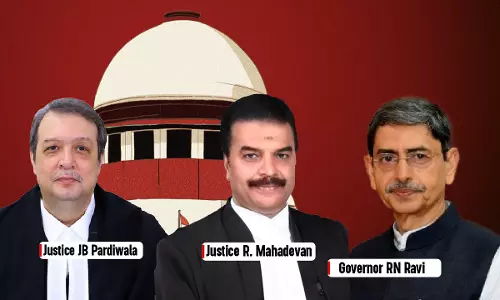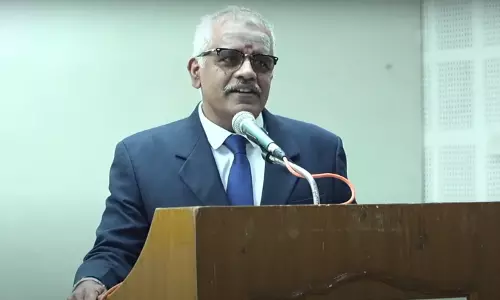The Doctrine Of Per Incuriam In Indian Jurisprudence: Implications And Judicial Responses

The Indian higher judiciary, represented by the Supreme Court and High Courts, plays a crucial role in adjudicating and interpreting laws within the country's legal framework. The decisions these courts render serve as binding precedents for the lower judiciary, guiding the application and interpretation of the law. Article 141 of the Constitution of India has the binding nature...
The Indian higher judiciary, represented by the Supreme Court and High Courts, plays a crucial role in adjudicating and interpreting laws within the country's legal framework. The decisions these courts render serve as binding precedents for the lower judiciary, guiding the application and interpretation of the law. Article 141 of the Constitution of India has the binding nature of Supreme Court rulings, stating, "The law declared by the Supreme Court shall be binding on all courts within the territory of India."
There are notable exceptions to this binding nature, specifically judgments rendered per incuriam and sub silentio. The term "per incuriam," meaning 'through lack of care,' refers to judgments passed without considering relevant legal authorities or statutes. Such decisions are considered wrongly decided due to the judges needing to be more informed about the applicable law and, as a result, cannot be used as precedents.
Black's Law Dictionary, Eighth Edition[1], the word 'per incuriam' has been defined as under:- "per incuriam (per in-kyoor-ee-em), adj. (Of a judicial decision) wrongly decided, usu. because the judge or judges were ill-informed about the applicable law. Advanced Law Lexicon by P. Ramanatha Aiyer's (5th edition)[2], it has been defined as under:- "Per incuriam. (Lat.) (of a judicial decision) wrongly decided, usually because the Judge or Judges were ill-informed about the applicable law. Through inadvertence or want of care. Through carelessness, through inadvertence. 'Per incuriam' means 'through want of care'—a mistaken decision of the Court.
The role of higher courts in resolving conflicts arising from per incuriam decisions is fundamental to preserving the legal system's coherence and integrity. Such judgments must be meticulously identified and addressed, ensuring they do not inadvertently influence the lower courts. The principle of stare decisis necessitates lower courts to follow the decisions of higher courts to make sure the legal system is predictable and consistent. However, judgments made per incuriam pose a unique challenge. According to the legal doctrine, decisions made per incuriam are not considered binding precedents. This creates a dilemma for the lower judiciary when they encounter higher court rulings that appear to have been made without due consideration of relevant laws or previous authoritative judgments.
The Synthetics and Chemicals Ltd. case (1991)[3] Clarified that judgments per incuriam are not binding on courts. However, this puts the lower judiciary in a precarious position of determining whether a higher court's decision falls within this non-binding category, potentially leading to legal uncertainty and inconsistency.
This approach upholds the sanctity of the law, fosters a more informed and careful judiciary at every level, and safeguards the principle of legal precedent across the Indian legal landscape.
Hierarchy Of Judiciary In India
“Doctrines of precedents and stare decisis are the core values of our legal system. They form the tools that further the goal of certainty, stability, and continuity in our legal system. Arguably, Judges owe a duty to the concept of certainty of law. Therefore, they often justify their holdings by relying upon the established tenets of the law. The doctrine of binding precedent is of utmost importance in the administration of our judicial system. It promotes certainty and consistency in judicial decisions.[4]” Maintaining consistency in the legal system fosters trust in it. Consequently, this Court's decisions must be consistent in articulating legal principles. The hierarchical structure of the Indian judiciary, consisting of the Supreme Court at the apex, followed by High Courts and Subordinate Courts, plays a crucial role in the development, interpretation, and application of legal precedents.
Article 141 states that the Law declared by the Supreme Court to be binding on all courts[5]-"The law declared by the Supreme Court shall be binding on all courts within the territory of India.” At the summit, the Supreme Court of India, with its original, appellate, and advisory jurisdictions, sets binding precedents for all lower courts, thereby ensuring uniformity and consistency in the legal system. High Courts, operating at the state level, possess both appellate and original jurisdiction, contributing significantly to the evolution of law through their judgments, which are binding on Subordinate Courts within their respective jurisdictions. However, their decisions may influence other High Courts and even be considered persuasive by the Supreme Court in specific contexts. Subordinate Courts, forming the base of the judicial pyramid, adhere to the precedents established by the higher courts, focusing on the application of law to individual cases. The principle of stare decisis, central to the doctrine of precedent, mandates that decisions made by higher courts are to be followed by lower courts, thereby ensuring a stable and predictable legal environment.
This hierarchical and precedent-centric approach facilitates a systematic legal interpretation, but it also faces challenges such as divergent judgments among High Courts, necessitating eventual harmonization by the Supreme Court. The dynamic nature of precedent within the Indian judiciary not only underscores the system's adaptability to evolving societal norms and values but also highlights the judiciary's crucial role in maintaining the rule of law, which reflects the need to strike a balance between the need for legal evolution in response to shifting cultural attitudes and the requirement for legal consistency.
Per Incuriam
The term "per incuriam" signifies a lack of care by the courts when passing decisions, leading to instances where important statutes are missed and judgments that are ignorant of the law are delivered. As per legal principles, these judgments, which are decided based on incorrect interpretations of the law, may cause legal and practical issues. Therefore, they are not treated as binding precedent, and the courts often take steps to correct them. In the higher judiciary, efforts are always made to rectify such decisions, as is evident in cases like Shah Faseal.
A decision should be considered as made per incuriam when it is made without awareness of the terms of a statute or a rule that has the statute's authority. Per incuriam means a decision rendered by ignorance of a previous binding decision of its own or a court of coordinate or higher jurisdiction or ignorance of the terms of a statute or of a rule having the force of law.[6] Whereby obvious inadvertence or oversight in cases where a judgement overlooks a clear legislative provision or mandatory authority that contradicts the logic and outcome reached, the per incuriam principle may be applicable.
Another exception to the rule of precedents is the doctrine of sub silentio. A decision is said to be passed sub silentio when the particular point of law involved in the decision is not perceived by the court or presented to its mind.[7] The decisions made sub silentio does not carry the same binding authority as decisions made explicitly on points of law. It is not determinative of the ratio decidendi and should not be treated as such. Professor P.J. Fitzgerald, who is the editor of the 12th edition of Salmond on Jurisprudence[8], clarifies the concept of sub silentio on page 153 as follows "A decision passes sub silentio, in the technical sense that has come to be attached to that phrase, when the particular point of law involved in the decision is not perceived by the court or present to its mind.”
Contributions from foreign jurisdictions to understanding the concept of "per incuriam" -According to Halsbury's Laws of England (4th Edn.) Vol. 26: Judgment and Orders: Judicial Decisions as Authorities[9] (pp. 297-98, Para 578) per incuriam has been elucidated as under: “A decision is given per incuriam when the court has acted in ignorance of a previous decision of its own or of a court of coordinate jurisdiction which covered the case before it, in which case it must decide which case to follow.”
In Lancaster Motor Company (London) Ltd. v. Bremith Ltd.[10]- “A decision passed sub silentio, in the technical sense that has come to be attached to that phrase, when the particular point of law involved in the decision is not perceived by the court or present to its mind" (Salmond 12th Edition)
In Young v. Bristol Aeroplane Co. Ltd[11] 1994, the House of Lords observed that "Incuria literally means carelessness. In practice per incuriam appears to mean per ignoratium. English courts have developed this principle in relaxation of the rule of stare decisis. The "quotable in law" is avoided and ignored if rendered in ignoratium of a statute or other binding authority. This Court has accepted, approved and adopted the same while interpreting Article 141 of the Constitution, which embodies the doctrine of precedents as a matter of law." Lord Goddard, C.J. in Huddersfield Police Authority v. Watson[12] stated that a decision delivered per incuriam would happen if a case or statute had not been brought to the court's attention and the court made the ruling without knowing about it or forgetting it even existed.
The principle of per incuriam and its implications on judicial precedents have been explored in various Supreme Court judgments. In State of U. P. v. Synthetics and Chemicals Ltd.[13], the Supreme court observed that- “The question was if the State Legislature could levy vend fee or excise duty on industrial alcohol. The Bench answered the question in the negative as industrial alcohol being unfit for human consumption the State Legislature was incompetent to levy any duty of excise either under entry 51 or entry 8 of the List II of the Seventh Schedule. While doing so, the Bench recorded the conclusion extracted earlier. It was not preceded by any discussion. No reason or rationale could be found in the order. This gives rise to an important question if the conclusion is law declared under article 141 of the Constitution or it is per incuriam and is liable to be ignored.”
In K.H. Siraj v. High Court of Kerala[14], (2006) 6 SCC 395 the Supreme Court held that a decision made by a High Court without reference to relevant Supreme Court decisions constitutes a per incuriam decision. This principle underscores the importance of judicial decisions being made considering existing precedents to maintain legal consistency and coherence.
Similarly in Siddharam Satlingappa Mhetre v. State of Maharashtra[15], the Court reiterated that judgments of coequal Benches are binding and observed that “Constitution of India Art. 141- Binding judgments - Not only larger Bench judgment but even judgment of coequal Bench, reiterated, binding - If court doubts correctness of such judgment then proper course is to refer the matter to larger Bench Present two-judge Bench, however held, bound by earlier Constitution Bench judgment - furthermore, judicial discipline obliges courts, tribunals, and the judiciary to adhere to this principle.”
It was submitted that the law laid down in para 42 by the Constitution Bench in Sibbia case[16], that That the customary practice is to not restrict the use of the anticipatory bail order was overlooked by the Supreme Court benches issuing later rulings. The legal ruling in Sibbia case para. 42 was binding upon them, although the observations made in the succeeding rulings were made without knowledge of it. That under these circumstances, the Constitution Bench's ruling and the remarks made in later rulings suggesting that anticipatory bail should be granted for a certain time should be interpreted as per incuriam.
Lastly in Chauharya Tripathi v. L.I.C.[17], the Supreme Court elaborated on the concept of per incuriamas - “Constitution of India Art. 141 Per incuriam decision What is and what is its precedential value - Legal position, stated Held, once judgment is declared per incuriam, it has no precedential value. Thus, held, R. Suresh, (2008) 11 SCC 319 cannot be regarded as precedent for proposition that Development Officer in LIC is a "workman" since the judgment does not say so and it was rendered in ignorance of ratio laid down by Constitution Bench in H.R. Adyanthaya, (1994) 5 SCC 737 and also principle stated by three-Judge Bench in Mukesh K. Tripathi, (2004) 8 SCC 387 that decision in S.K. Verma, (1983) 4 SCC 214 was not a precedent as S.K. Verma was held to be per incuriam by Constitution Bench in H.R. Adyanthaya - Thus, pronouncement in R. Suresh case, held, per incuriam - Industrial Disputes Act, 1947, S. 2(s)”
The principle of per incuriam must, however, be applied cautiously. A bench of a coordinate jurisdiction considering the case later may find that an earlier decision was incorrect on the grounds that a possible aspect of the case was not taken into consideration or raised before the court or that the court should have looked into more aspects when making its decision earlier. However, this does not establish that the decision was made per incuriam and is subject to be disregarded. The earlier judgment may seem to be incorrect, but it will have a binding effect on the later bench of coordinate jurisdiction until and unless it is overruled by a larger bench.[18]
In conclusion, the doctrine of per incuriam is a crucial aspect of Indian jurisprudence, providing a safeguard against erroneous judicial decisions. By allowing courts to rectify judgments made without due consideration of relevant legal authorities or statutes, this doctrine upholds the integrity and consistency of the legal system. The hierarchical structure of the Indian judiciary, with the Supreme Court at its apex, ensures that rulings from higher courts are legally enforceable precedents for lower courts, fostering certainty and stability in legal interpretations.
However, applying the per incuriam doctrine poses challenges, particularly in determining when a judgment falls within this category. While the reliance on stare decisis mandates lower courts to follow higher court decisions, judgments made per incuriam are not considered binding precedents, leading to potential legal uncertainty and inconsistency. Efforts to identify and rectify such decisions underscore the judiciary's commitment to ensuring the accurate application of the law.
Insights from foreign jurisdictions contribute to a deeper understanding of the per incuriam doctrine and its implications on judicial precedents. These insights reaffirm the importance of judicial decisions being made carefully considering existing precedents to maintain legal consistency and coherence.
In essence, the doctrine of per incuriam serves as a vital tool for maintaining the sanctity of the law, fostering a more informed and careful judiciary, and safeguarding the principle of legal precedent across the Indian legal landscape. As the legal system continues to evolve, the consistent application and understanding of per incuriam will remain essential for ensuring justice and upholding the rule of law in India.
Views are personal.
[8]John William Salmond, Salmond on Jurisprudence 321 (12th ed., P.J. Fitzgerald ed., Sweet & Maxwell 1966).




